

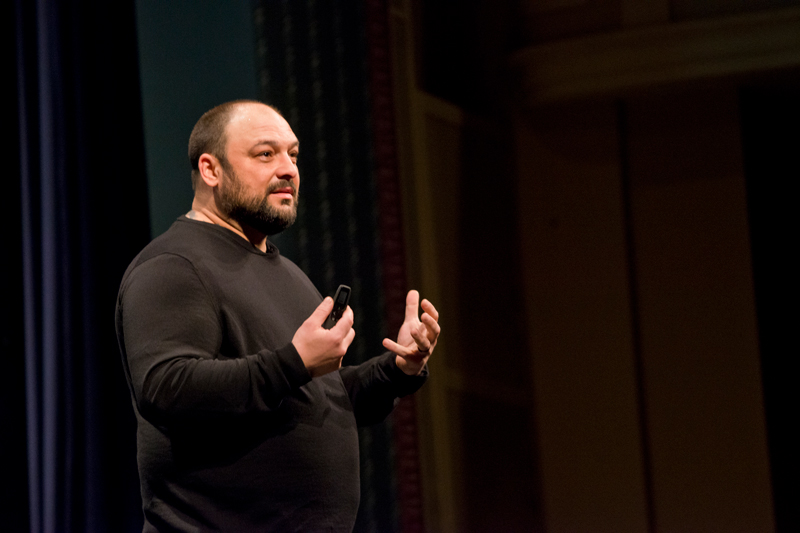
The speech divide
Photos by Kathy Atkinson and Lane McLaughlin April 04, 2019
UD conference explores public intersection of free speech and hate
Almost 30 years ago, an 18-year-old skinhead from Chicago’s South Side took his band overseas to play for 4,000 white supremacists. When his music sparked a riot, young Christian Picciolini got his first glimpse of the “the consequence of my words.”
Those consequences would follow him through the years.
Decades after denouncing the hate group he once led, and years after writing those lines of white-power fury, Picciolini would stumble upon his lyrics again, now online, where an inspired young fan would seek out their origins before killing nine African Americans in a South Carolina church.
Words of hate continue to resonate in horrifying ways around the world, across America, and within our global, digital platforms, posing a dilemma for a nation that reveres its freedom of speech, experts said on March 14-15 at a gathering hosted by the University of Delaware.
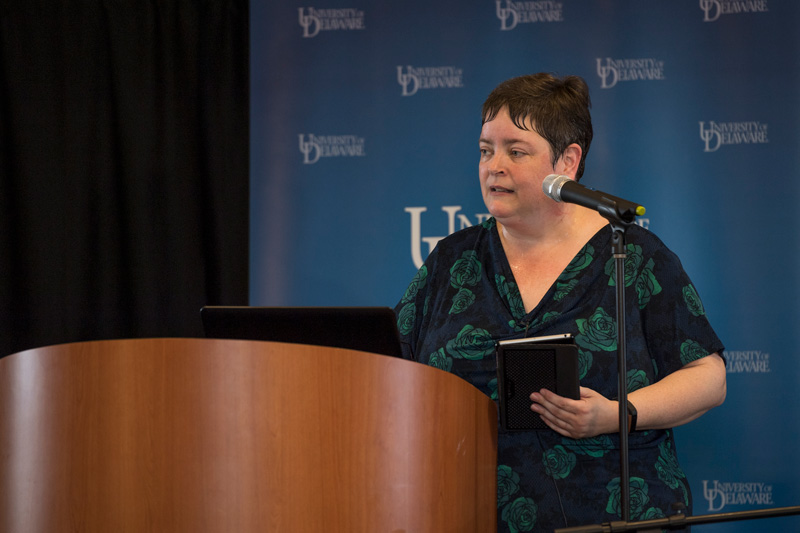
In a conference that began with Picciolini’s talk, dozens of scholars, students and social scientists examined “Speech Limits in Public Life: At the Intersection of Free Speech and Hate.”
Hate groups have grown by 30 percent in the last four years, according the Southern Poverty Law Center, and social media algorithms promote content that excites and incites, raising the stakes in the free speech divide. Just hours after Picciolini’s talk, a white supremacist killed 50 men, women and children in two New Zealand mosques, livestreaming the carnage and casting a painful and pertinent shadow over the day’s conversation.
What is speech?
In many ways, the UD conference aimed to uncover the very question sophomore Mia Carbone asked in an audio essay sponsored by UD’s Center for Political Communication and made available to the nearly 200 attendees: “Where is the line between things we don’t want to hear and things that shouldn’t be said?”
She was referring to a class discussion around Brett Kavanaugh’s Supreme Court appointment, and the trepidation of a lone male student who spoke in his defense, but Carbone was also reflecting the inherent tension of speech in 2019: There is no consensus on what speech is or should be.
Is money speech or do corporations have First Amendment rights, as the Citizens United Supreme Court case decided? Are lyrics like Picciolini’s “Skinheads have the upper hand/white men’s strength will save our land” permissible on social media?
What is the online equivalent of yelling “fire” falsely in a crowded room? Who decides what can be said, and where? And are universities operating “under the guise of speech codes” to “restrict free thought,” as President Donald Trump asserted earlier this month?
“Robust ideas require robust protections of free speech,” said Tim Shiell, event panelist and professor of philosophy at the University of Wisconsin- Stout. When it comes to promoting free speech and creating a culture of inclusion and equality, “universities are not supposed to pick one,” he said, “they’re supposed to do both.”
At the same time, it’s clear that in today’s atmosphere, professors are losing their jobs over statements that were hurtful and offensive, but legally protected, said Samantha Harris, another panelist and vice president of policy research at the Foundation for Individual Rights in Education. Such cases only diminish an institution’s ability to discuss difficult issues, she added.
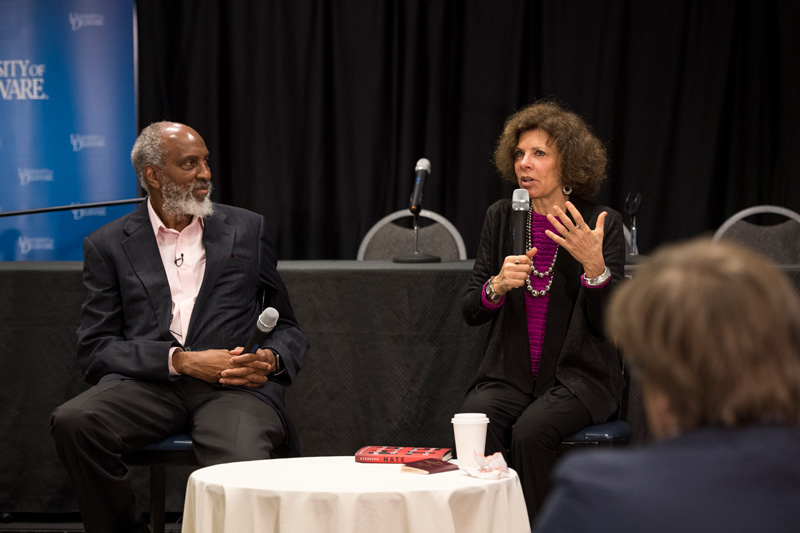
For that very reason, society must consider whether its efforts to stem hate speech might have their own negative consequences, said speaker Nadine Strossen, the Marshall Harlan II Professor of Law at New York Law School and former president of the American Civil Liberties Union. “People can be too quick to condemn speech as ‘hateful’ simply because they don’t agree with it.”
And yet courts have held that free-speech rights can be outweighed by society’s interest in “order and morality,” said panelist Rodney Smolla, dean of the Delaware Law School of Widener University. “Then, in the 1960s, everything changed. A lot of our constitutional law flipped upside down,” he noted, as Supreme Court cases protected hate speech as a First Amendment right.
In today’s cultural environment, that 1960s-era doctrine is again being countered by “order and morality” concerns, Smolla said. “In that sense, it’s unfair to conclude that today’s younger generation doesn’t understand the importance of free speech, they just understand it differently.”
Speech and social media
If the parameters for speech weren’t muddled enough, social media has added a complex and unprecedented new layer.
With more than 300 hours’ worth of content uploaded to YouTube every minute, there is no possible method for pre-publication human review, said panelist Emma Llansó, director of the Center for Democracy and Technology’s Free Expression Project. “Something like hate speech is so much harder for an automated program to identify,” she noted, adding that definitions of “hate speech” can vary by locale.
Meanwhile, hate-mongers lurk in every corner of the web, reformed white supremacist Picciolini warned. They stalk gaming platforms, chatrooms, self-help forums and, yes, YouTube — offering comfort and counsel to marginalized, impressionable youth. Through technology, he said, “Kids at 10 are ‘smarter’ Nazis than I was at 23.”
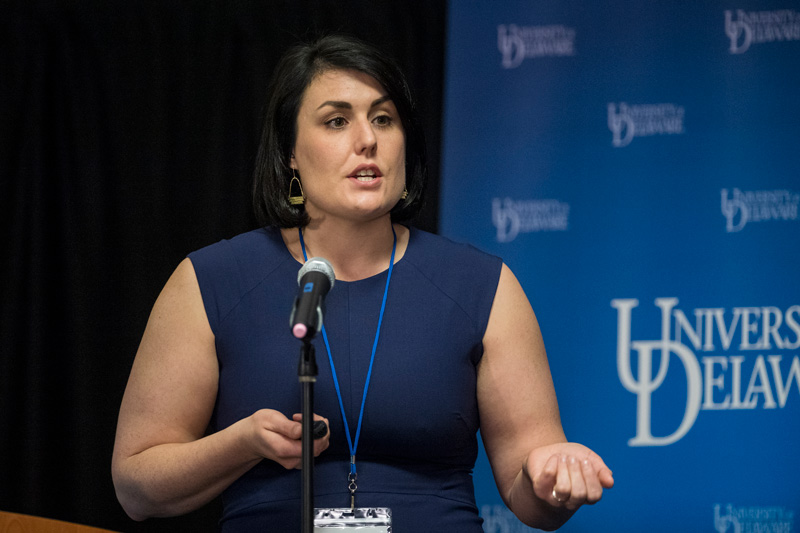
Then, there’s the basic business model of social media sites like Facebook, which link commerce to content, said Sara Wachter-Boettcher, author of Technically Wrong: Sexist Apps, Biased Algorithms and Other Threats of Toxic Tech. Studies have found that posts that stoke negative emotions like fear and anger tend to perform well — maximizing both their promotion and their potential for harm.
As an example, she cited a 2018 study that examined more than 3,000 anti-refugee attacks in Germany and found towns with higher-than-average Facebook use experienced more attacks on refugees, regardless of the town’s size, demographics, economy or even political make-up. Wherever Facebook use rose to one standard deviation above the national average, attacks on refugees increased by nearly 50 percent.
“The business model is optimized for abuse,” Wachter-Boettcher said, citing Facebook’s 37 percent increase in annual advertising revenue (up from $40 billion in 2017 to $55 billion in 2018). “These are not oversights. These are choices. Even as companies claim to fight abuse, they allow it to happen.”
Agents of Change
And yet, hope exists.
Speaking on a panel that examined non-legal responses to hate speech, 18-year-old Trisha Prabhu discussed her solution to cyberbullying: using technology to merge brain science with good behavior.
Because the portion of the brain that controls decision making and impulse control is the last to fully develop (from age 13 to 25), teens don’t evaluate situations and consider the potential consequences of their actions, she learned. Prabhu then began to wonder, “What if I could give teens a second chance to reconsider their words?”
She developed the ReThink app, which alerts users to “rethink” their posts, and showed users in the app’s test-run changed their minds 93 percent of the time. Moreover, the overall willingness to post an offensive message reduced from 71 percent to 4 percent for those using the app.
“I am a woman of color running a tech startup,” Prabhu said. “Venture capitalists often tell me, ‘There’s something off about you.’ The fact is, there’s no right time or right person [to make change]. It’s on all of us.”
That message of agency was at the very heart of the conference’s goals, said event organizer and UD Associate Communication Professor Jenny Lambe.
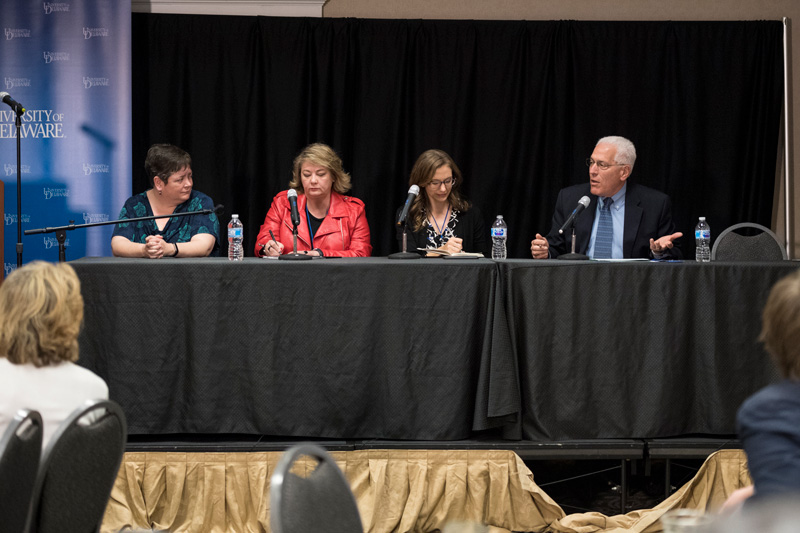
“The free speech conversation often stops at policy, at whether we should pass more laws to guard against hate speech,” she said. “But other ways may actually be more effective and less challenging to free expression.”
From the Southern Poverty Law Center’s database of active hate groups in America to people blocking funeral protests by the Westboro Baptist Church with large angel costumes, Lambe said she finds hope in innovative solutions. “It’s not impossible to combat hate speech,” she said, “but it’s going to take multiple methods.”
It will also require reevaluating our very communication goals, according to john a. powell, director of the Haas Institute for a Fair and Inclusive Society and a professor of law and ethnic studies at the University of California, Berkeley. (He spells his name in lowercase in the belief that we should be “part of the universe, not over it, as capitals signify,” according to a UC Berkeley News story.)
“Ninety percent of speech is not about truth finding; it’s about relationships,” he said. “And right now, we’re choosing not to have them: ‘I don’t want a relationship with you because you’re Muslim’ or ‘I don’t want a relationship with you because you’re a Trump supporter.’”
But as Picciolini has learned from ISIS militants and white power terrorists alike, compassion is the only force strong enough to break hate.
“Find someone who you don’t feel deserves your compassion and give it,” he said. “They may not deserve it, but they’re the ones who need it most.”
About the Conference
"Speech Limits in Public Life" was made possible with support from the Institute for Humane Studies at George Mason University and the University of Delaware's Office of the President, Office of the Provost, Office of the Vice Provost for Diversity, the Class of ’55 Ethics Endowment Fund and the College of Arts and Sciences’ dean’s office, its Department of Communication and numerous other departments. Cosponsors are the Heterodox Academy and the UD Center for Political Communication.
Contact Us
Have a UDaily story idea?
Contact us at ocm@udel.edu
Members of the press
Contact us at 302-831-NEWS or visit the Media Relations website

